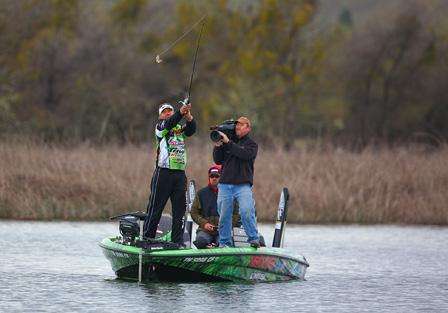
It's late fall, and throughout most of the country the bass are still feeding up for the winter. That means big catches in backwater, shallow areas with a variety of baits, including smaller swimbaits.
Before we get too far along, however, let me encourage you to stay with your fall pattern for a little while longer. In my experience, far too many anglers abandon it before they should. Just because you think it's cold and miserable doesn't mean the fish think that way. Depending upon where you are, there may even be a few schoolers left. If so, match the hatch with your swimbait, throw directly into the school and crank it back. You'll do just fine.
If they're in the backs of the creeks, your fishing life is about to get even better. Fish topwater baits or maybe a spinnerbait in shallow, cover-laden areas and take all the bass you can from an area. Then use your swimbait as a clean-up lure. You'll be surprised at how many more fish you can boat by doing this.
The trick to using a swimbait for clean-up in the late fall is size.
Throw a really small one. In most lakes and rivers, 2 inches is about right. And you'll do best almost everywhere with a shad color of some sort. Most of the national companies have something suitable on the market. That said, however, this is the time of the year when locally made baits come into their own. Locals know what the forage looks like in their neighborhood, and they can be amazingly adept at duplicating it. Take advantage of that.
I don't think it matters much if the bait is soft or hard. The important thing is that it looks and swims with a natural action. For the most part, these smaller lures are lighter than normal-size swimbaits.
To fish them efficiently you'll need a lighter rod with a really soft tip. That'll make a world of difference when you cast them. (Duckett Fishing's Micro Magic line has several that'll fill the bill.) High-speed reels are a must. A 7:1 gear ratio or better will allow you to move the bait through the strike zone and then get it back quickly. And don't kid yourself: Modern high-speed gears are plenty strong enough to handle most bass. The old rap on them was that they lacked strength.
Thanks to modern engineering, that isn't true anymore. (My reel preference is the Abu Garcia Revo line.) I use the lightest monofilament line possible at this time of the year. Braid is too heavy for light lures and fluorocarbon sinks too fast for use in shallow water. I go with light test weights because fall waters tend to be clear, and light line is less visible.
Besides, light line will allow your bait to work more naturally. Heavy line will destroy its action. (In my opinion the best monofilament line is Berkley Trilene.) In short, what I'm trying to say in this lesson is don't fall into the trap of thinking that swimbait fishing is all about big lures and heavy tackle. Go light in the late fall for heavy sacks of bass.





